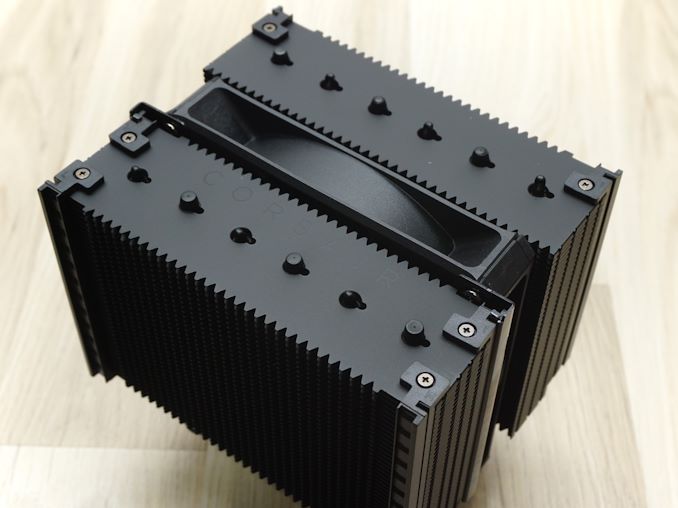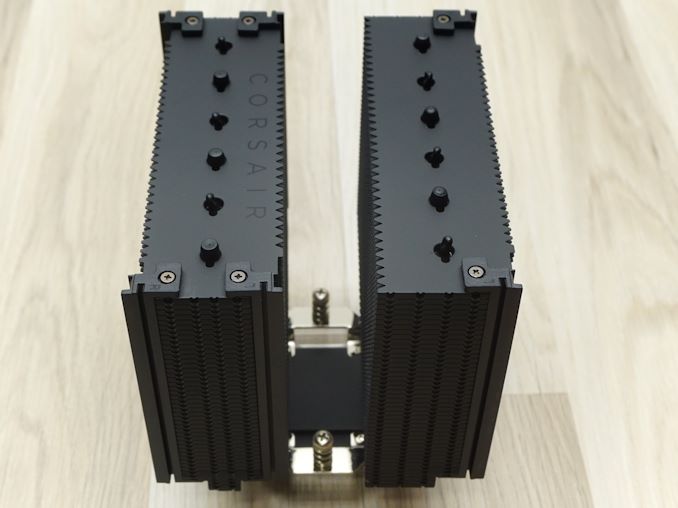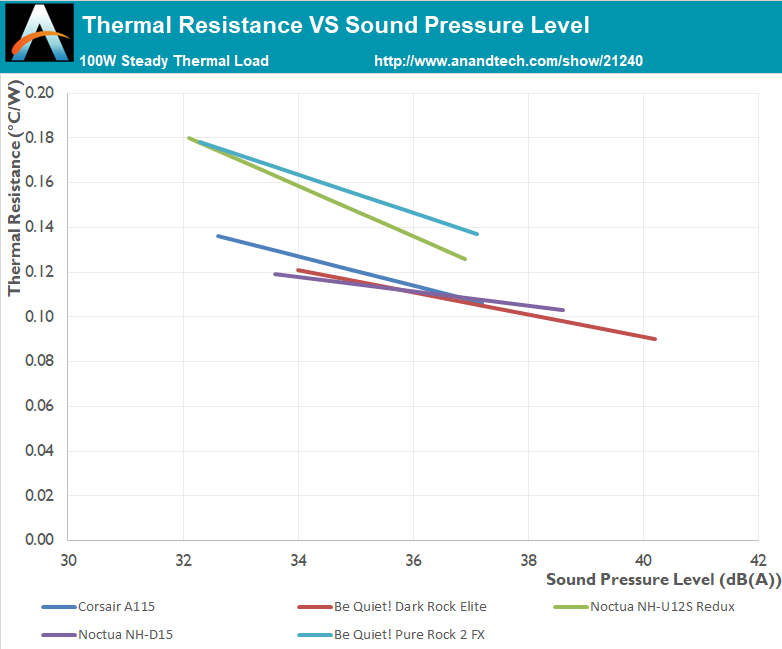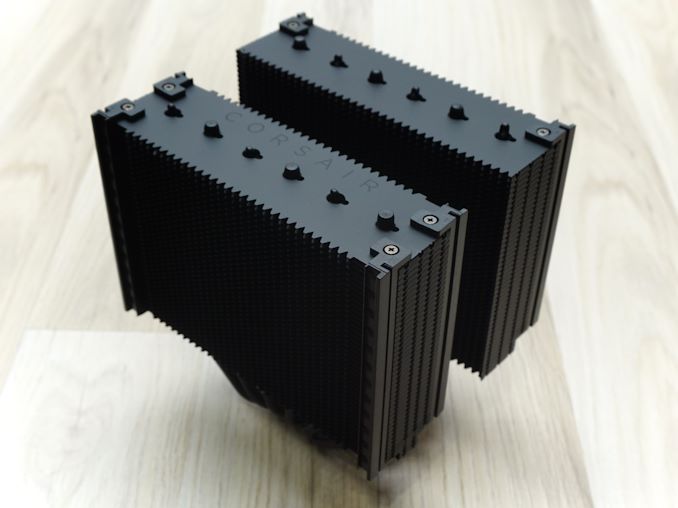
The Corsair A115 CPU Cooler Review: Massive Air Cooler Is Effective, But Expensive
2024-01-22With recent high-performance CPUs exhibiting increasingly demanding cooling requirements, we’ve seen a surge in releases of new dual-tower air cooler designs. Though not new by any means, dual-tower designs have taken on increased importance as air cooler designers work to keep up with the significant thermal loads generated by the latest processors. And even in systems that aren’t running the very highest-end or hottest CPUs, designers have been looking for ways to improve on air cooling efficiency, if only to hold the line on noise levels while the average TDP of enthusiast-class processors continues to eke up. All of which has been giving dual-tower coolers a bigger presence within the market.
At this point many major air cooler vendors are offering at least one dual-tower cooler, and, underscoring this broader shift in air cooler design, they’re being joined by the liquid-cooling focused Corsair. Best known within the PC cooling space for their expansive lineup of all-in-one (AIO) liquid PC CPU coolers, Corsair has enjoyed a massive amount of success with their AIO coolers. But perhaps as a result of this, the company has exhibited a notable reticence towards venturing into the air cooler segment, and it’s been years since the company last introduced a new CPU air cooler. This absence is finally coming to an end, however, with the launch of a new dual-tower air cooler.
Our review today centers on Corsair’s latest offering in the high-end CPU air cooler market, the A115. Designed to challenge established models like the Noctua NH-D15, the A115 is Cosair’s effort to jump in to the high-end air cooling market with both feet and a lot of bravado. The A115 boasts substantial dimensions to maximize its cooling efficiency, aiming not just to meet but to surpass the cooling requirements of the most demanding mainstream CPUs. This review will thoroughly examine the A115’s performance characteristics and its competitive standing in the aftermarket cooling market.
| Corsair A115 CPU Cooler Specifications | |||
| Type | Tower Cooler (Twin) | ||
| Dimensions | 153 x 155 x 164.8 | ||
| Fans | 2 x 140 mm Corsair AF140 fan 1600RPM (max) |
||
| RGB | No | ||
| Supported Sockets | Intel: LGA1700, LGA1200, LGA115x
AMD: AM5, AM4 |
||
| Warranty | 5 Years | ||
| Price | $99.99 | ||
Corsair supplies the A115 in a fairly large cardboard box with the company’s signature yellow/black design theme. The aesthetic design is rather minimal, with a picture of the cooler itself decorating the front side of the package. Plenty of information about the cooler can be found on the rear of the packaging but, more importantly, there is a QR code that leads to the comprehensive online manual.
Upon unboxing the Corsair A115 CPU cooler, it becomes evident that the packaging adopts a methodical and organized approach. Each piece of the mounting hardware, essential for installation, is neatly segregated in individual paper bags, simplifying the setup process. This meticulous packaging reflects Corsair’s attention to detail and commitment to user convenience. The mounting hardware provided is comprehensive, ensuring compatibility with most current CPU sockets. This includes support for Intel sockets (1700 / 1200 / 115x) as well as AMD sockets (AM5 / AM4).
The Corsair A115 makes its presence known in the tower CPU cooler category with its impressive design. It features six highly efficient 6 mm sintered copper heat pipes, expertly designed to transfer heat from the base to the twin fin arrays. One array is a little smaller, providing better clearance to adjacent heatsinks and/or RAM modules. Standing at a height of 164.8 mm, this cooler is substantial in size and requires careful consideration for compatibility, particularly in larger ATX cases. And for that matter, consideration is needed when moving it around as well; with a weight of 2.2 kg (4.85 lbs), the A115 is extremely heavy, making it a very good idea to avoid vigorously moving a system around with the cooler installed in order to prevent potential damage.
On the Corsair A115, the fins are designed with efficiency and noise reduction in mind. While the cooler doesn’t have recessed fins specifically to reduce turbulence noise, the overall design still aims to minimize acoustic output while maintaining airflow efficiency. The sawtooth fins, although not asymmetric like in some other models, are crafted to optimize aerodynamic performance, enhancing air circulation and heat dissipation. The company logo is very subtly etched at the top of one fin array, barely visible.
The Corsair A115 also pays attention to compatibility with various motherboard layouts. Its design accommodates VRM heatsinks commonly found on motherboards, ensuring that it does not interfere with other components. This thoughtful design consideration ensures a high degree of adaptability to different system configurations. While these design choices might slightly affect the total heat transfer surface area, they significantly boost the cooler’s versatility, offering a well-balanced solution in terms of efficiency and compatibility with a range of PC builds. Regardless, the heat transfer surface area remains ample, at the expense of unexpectedly wide fins that make the A115 one of the bulkiest heatsinks we have ever tested.
Examining the hulking mass as a whole, it’s clear that Corsair aimed to put together a pure tower air cooler that could stand up to today’s hot chips, as well as standards set by their own AIO liquid coolers. That’s no small feat – but then, accomplishing this requires no small cooler, either.
The Corsair A115 cooler boasts a rail mounting design for its fans, a feature that greatly enhances its compatibility with a variety of RAM configurations. This innovative rail design allows for adjustable height settings of the fan, providing considerable clearance over the RAM slots. This adjustability is especially beneficial for systems equipped with taller DIMMs or larger RAM modules. However, it’s important to keep in mind that adjusting the front fan height to accommodate taller RAM modules will also increase the total height of the cooler. This necessitates wider case to accommodate the adjusted setup. Additionally, raising the front fan excessively may impact both the performance and the overall aesthetic cohesion of the build. Although height adjustments are not useful for the center fan, the rail makes its removal a matter of seconds, allowing the quick installation/removal of the cooler when necessary.
The base of the Corsair A115 is a little more intricate than what we typically see in standard tower cooler designs. It is a split design, with a copper contact plate and a top support plate with steel retention arms sandwiching the heatpipes in between them. The A115 comes with pre-applied thermal XTM70 paste, meticulously applied to guarantee optimal spread upon installation.
A key highlight of the Corsair A115 is its inclusion of high-quality PWM fans, which are a step away from the LED-lit fans seen in other models. The A115’s AF140 fans do not feature LED lighting, focusing instead on pure performance and clean aesthetics. These fans are designed with fluid-dynamic motors and blades optimized for guided airflow, promoting effective heat dissipation. For the current retail price of the cooler, however, we hoped to see MagLev fans included. The 140 mm fans on the A115 can reach up to 1600 RPM.
Although the testing of a cooler appears to be a simple task, that could not be much further from the truth. Proper thermal testing cannot be performed with a cooler mounted on a single chip, for multiple reasons. Some of these reasons include the instability of the thermal load and the inability to fully control and or monitor it, as well as the inaccuracy of the chip-integrated sensors. It is also impossible to compare results taken on different chips, let alone entirely different systems, which is a great problem when testing computer coolers, as the hardware changes every several months. Finally, testing a cooler on a typical system prevents the tester from assessing the most vital characteristic of a cooler, its absolute thermal resistance.
The absolute thermal resistance defines the absolute performance of a heatsink by indicating the temperature rise per unit of power, in our case in degrees Celsius per Watt (°C/W). In layman’s terms, if the thermal resistance of a heatsink is known, the user can assess the highest possible temperature rise of a chip over ambient by simply multiplying the maximum thermal design power (TDP) rating of the chip with it. Extracting the absolute thermal resistance of a cooler however is no simple task, as the load has to be perfectly even, steady and variable, as the thermal resistance also varies depending on the magnitude of the thermal load. Therefore, even if it would be possible to assess the thermal resistance of a cooler while it is mounted on a working chip, it would not suffice, as a large change of the thermal load can yield much different results.

Appropriate thermal testing requires the creation of a proper testing station and the use of laboratory-grade equipment. Therefore, we created a thermal testing platform with a fully controllable thermal energy source that may be used to test any kind of cooler, regardless of its design and or compatibility. The thermal cartridge inside the core of our testing station can have its power adjusted between 60 W and 340 W, in 2 W increments (and it never throttles). Furthermore, monitoring and logging of the testing process via software minimizes the possibility of human errors during testing. A multifunction data acquisition module (DAQ) is responsible for the automatic or the manual control of the testing equipment, the acquisition of the ambient and the in-core temperatures via PT100 sensors, the logging of the test results and the mathematical extraction of performance figures.
Finally, as noise measurements are a bit tricky, their measurement is being performed manually. Fans can have significant variations in speed from their rated values, thus their actual speed during the thermal testing is being recorded via a laser tachometer. The fans (and pumps, when applicable) are being powered via an adjustable, fanless desktop DC power supply and noise measurements are being taken 1 meter away from the cooler, in a straight line ahead from its fan engine. At this point we should also note that the Decibel scale is logarithmic, which means that roughly every 3 dB(A) the sound pressure doubles. Therefore, the difference of sound pressure between 30 dB(A) and 60 dB(A) is not “twice as much” but nearly a thousand times greater. The table below should help you cross-reference our test results with real-life situations.
The noise floor of our recording equipment is 30.2-30.4 dB(A), which represents a medium-sized room without any active noise sources. All of our acoustic testing takes place during night hours, minimizing the possibility of external disruptions.
| <35dB(A) | Virtually inaudible |
| 35-38dB(A) | Very quiet (whisper-slight humming) |
| 38-40dB(A) | Quiet (relatively comfortable – humming) |
| 40-44dB(A) | Normal (humming noise, above comfortable for a large % of users) |
| 44-47dB(A)* | Loud* (strong aerodynamic noise) |
| 47-50dB(A) | Very loud (strong whining noise) |
| 50-54dB(A) | Extremely loud (painfully distracting for the vast majority of users) |
| >54dB(A) | Intolerable for home/office use, special applications only. |
*noise levels above this are not suggested for daily use
To begin with, we are taking a look at the Corsair A115 with its stock 140 mm fans running at their maximum speed. Both fans run at exactly 1600 RPM, suggesting exceptional quality control.
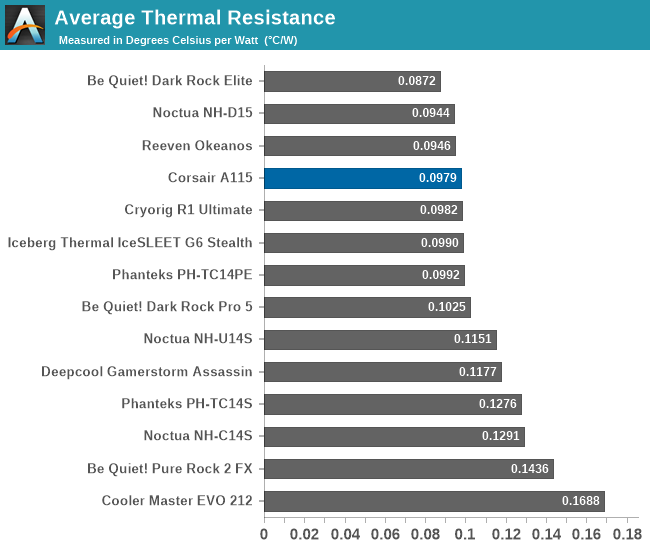
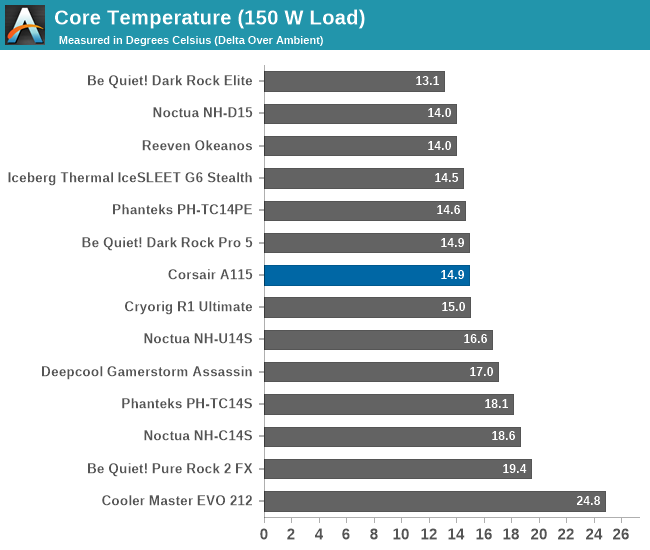
| Core Temperature, Constant Thermal Load (Max Fan Speed) |
The performance data of the Corsair A115 places it as a strong contender in the high-end air-cooling market, with its thermal resistance in line with many competitive products. With an average thermal resistance of 0.0979 °C/W at maximum fan speed, it shows adeptness in handling high thermal loads, even though it may not be the top performer in every scenario. The cooler is particularly effective under heavier loads, aligning with its design for demanding CPU applications, yet seems to struggle to keep performance figures high when the load is low.

The A115’s fans and design manage to keep noise levels relatively low. There is little-to-no turbulence noise, suggesting both low airflow resistance and intended design. At full speed, the noise level reaches 37.2 dB(A), which is quite manageable, especially considering the cooler’s dual 140 mm fan setup. This level of noise, albeit not the quietest, is commendable for a cooler operating at this capacity, indicating a good balance between cooling efficiency and noise control.

In this test we are switching things up a bit, taking a look at the cooler’s performance with the AF140 fans taken down to half speed.


| Core Temperature, Constant Thermal Load (Low Fan Speed) |
Lowering the fan speed of the Corsair A115 to 800 RPM inevitably affects its thermal performance, albeit slightly more than one might expect theoretically. With an average thermal resistance rising to 0.1333 °C/W at this reduced speed, the cooler’s performance remains excellent, but it does lose some competitive edge against major rivals in terms of raw thermal efficiency. While still performing admirably, it doesn’t hold the top position in thermal performance charts, and its acoustic performance under these conditions becomes an important factor.

At this 800 RPM speed, the noise level of the A115 drops to 32.6 dB(A). This level is very quiet, barely noticeable in typical home office environments. The cooler becomes virtually undetectable except in extremely quiet settings, where there are no other sources of noise. Regardless, that kind of performance is not out-of-reach for most of its direct competition.
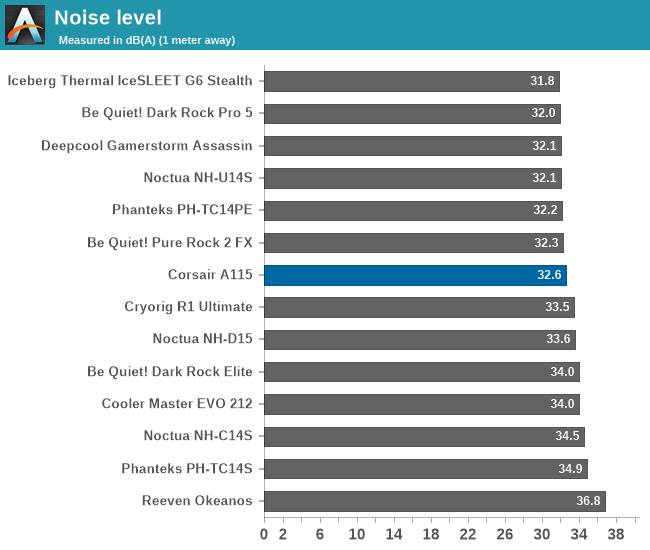
During our thermal resistance vs. sound pressure level test, we maintain a steady 100W thermal load and assess the overall performance of the coolers by taking multiple temperature and sound pressure level readings within the operating range of the stock cooling fans. The result is a graph that depicts the absolute thermal resistance of the cooler in comparison to the noise generated. For both the sound pressure level and absolute thermal resistance readings, lower figures are better.
The performance analysis of the Corsair A115 CPU cooler, when compared to industry benchmarks like Noctua’s NH-D15 and Be Quiet!’s Dark Rock Elite, is quite revealing. At its maximum fan speed of 1600 RPM, the A115 matches the cooling performance of these renowned competitors, an impressive accomplishment considering its straightforward design. However, when the fan speeds are reduced to 800 RPM, the A115 tends to fall slightly behind in performance. The potential use of MagLev fans in the A115 could offer an advantage, potentially lowering its performance curve and giving it a slight edge over competitors in certain scenarios.
Overall, the Corsair A115 stands out with its impressive performance, especially given its relatively straightforward design. The build quality of the A115 is exceptional, showcasing Corsair’s commitment to durability and reliability. However, its retail price of $100 positions it in a challenging spot within the competitive market.
The A115’s superior build quality and aesthetically pleasing design are evident. Corsair’s meticulous attention to detail and high craftsmanship standards are visible, contributing significantly to its durability and longevity. The A115 features robust materials, including sintered copper for the heat pipes that are soldered on the fin arrays and not just pressed, ensuring both good out-of-the-box performance and long-term reliability. The simple but stout construction of the A115 ensures it withstands long-term use.
The Corsair A115 excels in cooling performance, particularly when dealing with high loads and operating at high fan speeds. However, it shows a slight decrease in efficiency when managing low loads and running at lower fan speeds. While the A115 is not overly loud, it doesn’t quite surpass its competitors in terms of noise-to-performance ratio. It performs admirably under demanding conditions but does not lead the pack in scenarios that require a delicate balance of minimal noise and cooling effectiveness.
In conclusion, the Corsair A115 CPU cooler is a solid choice for those seeking a well-built, reliable, and high-performance air cooling solution. Its design focuses on ease of use and durability, making it a dependable option for various computing needs. However, its high retail price of $100 is a notable factor that affects its competitiveness in the market. The cooler could present a more compelling value proposition at a lower price point or if it included advanced features such as top-tier MagLev fans. While its performance and build quality are commendable, the pricing positions it as a premium choice, potentially limiting its appeal to a broader audience.




